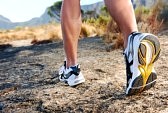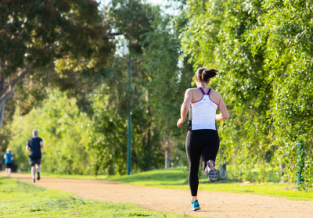Preparing Your Feet For The 2015 Oxfam Trailwalker
Published on
12 Feb 2015

Call us on: (03) 9975 4133
Signed up for the Oxfam 100km Trailwalker? Our resident podiatrist Ben Westaway discusses how to prepare your feet for the 100km trail!
Signed up for the Oxfam 100km Trailwalker? Congratulations! Taking part in in this event will be a grand achievement. The 10th of April is quickly approaching and the eight-week countdown is on!
The following article will arm you with a checklist and timeline for this challenging event. It offers information to help you (i) ensure you are well prepared, (ii) have smart footwear choices in place, and (iii) have a well equipped repair kit for the most important body parts in a 100km walk – your feet!
Chances are that by now you have three committed friends and that you have submitted your team entry. You have been building your base of fitness and can walk 20km with relative comfort. (If this isn’t you, then get cracking!) Lets look at some of the big components to successfully completing this monster task:
Shoe Selection
Good news – the next two weeks is the time to treat yourself to a new pair of shoes! This will be the first of two pairs you need to think about purchasing.
Pair #1 – A comfortable running shoe. We say running shoe and not cross-trainer for a number of reasons. A runner is perfectly adapted to straight-line activity and is built with cushioning at distance as its key design feature.
Pair #2 – We highly recommend that your second pair of shoes is a trail running shoe. Plenty of people tackle the Oxfam Trailwalk in far more serious off-road footwear such as hiking boots. Hiking boots are heavy, rugged and rather hard to carry over 100km. They seem like overkill. The trail walker is by no means technical off-roading.
Consider wearing your shoes at about a 70/30 split: 70% of time in your runners 30% in your trail runners. This is a good time to mention – get to know the trail. Walk it in sections where possible. Know where you would be more comfortable in each of your two pairs of shoes.
With each of your new shoes, be sure to undergo a gradual wear-in process as you allow musculature of your lower limb to adapt to this new platform. The first time you wear them should be relatively short; a 20-30min walk. Increase gradually, listening to your body. If you are pulling up well after a walk, green light to increase mileage gradually. However, if you are pulling up a little sore, listen to you body. Maintain that shorter distance for a few more walks.
“Do I need to buy a new pair of shoes?” we hear you asking. “Mine look fine!”.
There is definitely a window of appropriateness for your footwear. Your shoes want to be worn in; and worn in means walking in them on no less than 10 occasions, with no less than 100km of use. But! No more than 600km of use in them. Do the math guys.
Your local specialty running retailer is a very valuable ally over this process. The ability to talk with someone who has expert knowledge in fitting footwear is invaluable. A retailer that allows you to walk/run in your shoes on a treadmill during the fit up process is great. Find your local specialty running store:
Active Feet – http://www.activefeet.com.au/
Running Fit – https://www.runningfit.com.au/
The Running Company – http://www.therunningcompany.com.au/
Sock Selection
Not as straightforward as it may seem. Only one thing is a certainty: select a sock with a technical capacity to effectively absorb or wick moisture from the foot – crucial in avoiding blistering.
Trial and error is as good as any method. Major considerations: length and thickness. Both are a personal preference and there is no right answer. Ankle socks or higher, thin or thick, try all and find something that works. Your local running specialty store is a wealth of knowledge in this area also.
First Aid Kit
Getting your shoe and sock selection in order and rehearsed is crucial but will not guarantee you will not see blistering. 100km is a long way!
You are best advised to have a first aid kit, either with you, or with your support crew. The following items are a must:
– Spare socks x3
– Second pair of shoes
– Foam dressing
– Film dressing
– Antiseptic
– Donut pad – Let me elaborate. Cut a circle out of the middle of a couple of your foam dressings, creating a donut looking pad. The cut out area is applied over any blistering or high friction areas to offload that area.
– Adhesive covering – Hypafix is one brand
– Scissors
If things go wrong stop and see one of the lovely volunteer podiatrists at aid stations along the way.
Physio and Podiatry
As you are increasing your mileage and training frequency you will notice a change in your body. Increased cardiovascular endurance, greater muscular strength in your legs and changes in body fat composition are all positive. But don’t neglect the negatives. The risk of overuse injury at this time is high. A niggling hamstring, a tight calf, or pain in your heel when you first get up in the morning are all signs of overload. Do not ignore these signs.
We highly recommend seeing a Physiotherapist in preparation for an event like this. Identifying areas of weakness, tightness or asymmetry left to right is invaluable in preventing overuse injuries.
Increased loading will very likely contribute to tightness in one region or another. Leading into the event is a good time to have regular soft tissue massage with a remedial massage therapist or sports massage therapist.
If you don’t own a foam roller yet – get one! And search YouTube for techniques to use it. They are exceptional for self-management of soft tissue.
If you have any questions about designing the final two months of your training, a Physio consultation can be very helpful. Please don’t ‘wing it’. Prepare and succeed.
If you are having trouble getting your footwear right, or if you have any questions, a Podiatrist can be very helpful. Chose a Podiatrist that works closely with a local specialty running store and that is skilled in gait assessment.
At PURE Physio,we provide integrated, thorough treatment for all of our patients.
Logging serious miles has serious effects on your feet! Thickened toenails, lost toenails, build up of callous, development of corns and blistering, are all very common. If these are affecting you and your training be sure to see a Podiatrist for treatment and advice now.
Before race day you need to have callous or corns removed as these WILL cause trouble over 100km.
Be sure to trim your toenails and, importantly – file them. No sharp edges.
Best of luck! Being well-informed, well prepared and having consulted with your Allied heath Professionals, you won’t need luck!
Pride Podiatry


